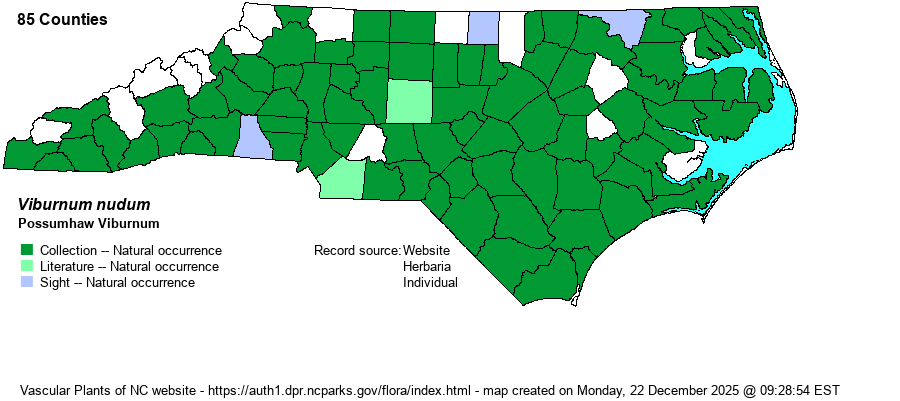| Author | L. | |
| Distribution | Throughout the Coastal Plain and most of the Piedmont. In the Mountains found only at low elevations. [Note: The BONAP map includes the montane V. cassinoides with this species; thus, the Mountain distribution of V. nudum is masked. We have checked specimens at UNC-CH vs. V. cassinoides and V. nitidum and believe that our map of V. nudum is correct.]
This species occurs over most of the eastern U.S., but does not quite range into Canada. It extends north to RI and NY and south to FL and TX, but it is not frequent west of, or in, the Appalachians.
| |
| Abundance | Common in the Coastal Plain and Sandhills, infrequent to fairly common in the Piedmont. Rare in the low Mountains. It usually does not occur in large numbers where it is found. | |
| Habitat | This is strictly a wetland species, favoring seepages, swamps, wet bottomlands, and streambanks, especially in blackwater floodplains in the Coastal Plain. It is usually found where water is slow-moving and quite acidic. It can be a characteristic shrub of the Low Elevation Seep natural community. |
| Phenology | Blooms in April and May, and fruits from August to October. | |
| Identification | This is a medium-sized to large deciduous shrub, growing to 10-15 feet high. The opposite leaves are essentially entire and elliptic (to variously lanceolate or oblanceolate), but narrower than the very similar V. cassinoides; they grow to 3-4 inches long. In addition, the leaves of V. nudum are very shiny/lustrous above, whereas V. cassinoides has a matte or dull luster; and the mid-vein of V. nudum is not strongly whited nor obvious to the eye. Its white flower cluster and its cluster of blue-black fruit with a whitish bloom are very similar to some other viburnum species. Most people identify this species by its growing in a seepage or in swampy ground and its conspicuously shiny and entire opposite leaves. See the account for V. nitidum, recently split out from V. nudum; the two are known to occur together. That newly split-out species has shorter yet narrower leaves, seldom more than 3 inches long and more than 1-inch wide, with a strongly acute tip. V. nudum (strict sense) has large leaves reaching about 3 inches long and 1.5 inches wide or wider, with an obtuse or broadly acute tip. | |
| Taxonomic Comments | Many references, though not Weakley (2018) or NatureServe, lump this species into one larger species, with V. cassinoides. Some authorities then name this taxon as V. nudum var. nudum, whereas others name it as V. cassinoides var. nudum. Note that V. nitidum has recently been pulled out from V. nudum.
| |
| Other Common Name(s) | This species has had difficulty being given a single common name that is in wide usage. Southern Wild-raisin, Possumhaw, and Southern Witherod are among such alternate names. | |
| State Rank | S5 | |
| Global Rank | G5 | |
| State Status | | |
| US Status | | |
| USACE-agcp | FACW link |
| USACE-emp | OBL link |

